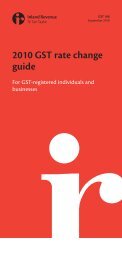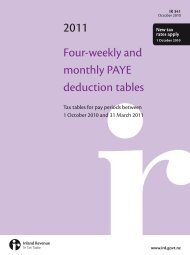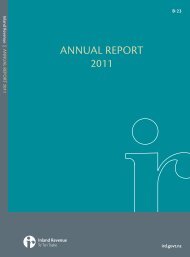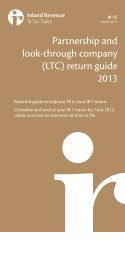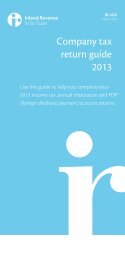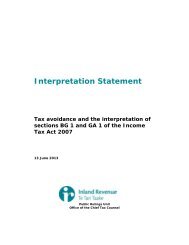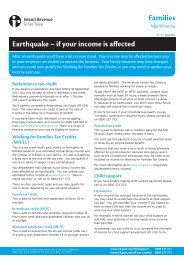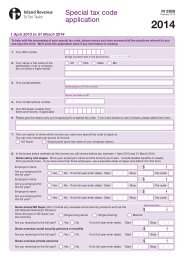Download - Inland Revenue Department
Download - Inland Revenue Department
Download - Inland Revenue Department
You also want an ePaper? Increase the reach of your titles
YUMPU automatically turns print PDFs into web optimized ePapers that Google loves.
8 IR 10 GUIDEFilling in the boxesFirst fill in the customer’s name and IRD number.1 Multiple activity indicatorTick “Yes” only if the customer has more than one line ofbusiness, not just several different divisions to the samebusiness.Here are some examples.• Customer has a window cleaning business and a paintingcontractor business—tick “Yes”.• Customer has a supermarket with an alcohol division, afruit and vegetable division, a delicatessen division and ageneral grocery division—tick “No”.• Customer has two gift shops, but uses one return—tick“No”.Complete only one IR 10 for each return.Income statement itemsBoxes 2 to 11Boxes 2 to 11 relate to the gross income of the business, andshould generally be obtained from the income statement(profit and loss account).2 Sales and/or servicesThis is the gross income from the sale of goods or servicesas shown in the income statement. It is also referred to asturnover. Include management fees and commissions if thisis the main source of income. Include gross salaries, wagesand schedular payments if it is the only income. If there istrading income and gross income such as salary, wages andschedular payments, include them in Box 10 (other income).
www.ird.govt.nz93 Opening stockThis is the total stock on hand, including raw materials,livestock, grain or produce used in the business, work inprogress and finished goods at the beginning of the year.The opening stock figure will generally be the same as theclosing stock shown in last year’s comparative figures in thebalance sheet (statement of financial position). If the figurecannot be obtained from this source check the cost of goodssold in the income statement.Work in progress represents the value of work started butnot completed. In manufacturing, it is partly finished goods,while in a contracting business, it is incomplete contracts.If the business provides a service, rather than selling goods,there may be no stock.4 PurchasesEnter the total amount of purchases and other direct costsas shown in the income statement. Sometimes only the costof goods sold is shown in the income statement. In thesecases, add closing stock to the cost of goods sold and deductopening stock. The answer should be treated as purchases,although it may include other direct costs. Direct costs(labour and other) of a business that provides services shouldbe treated as purchases. Do not include purchases of assetswhere the proceeds of sale of the assets have been includedin Box 26 (exceptional items).
www.ird.govt.nz119 Rental, lease and licence incomeEnter the amount of gross rental, lease, licence and hireincome before expenses as shown in the income statement.Include income from land, buildings, vehicles, fishing quotasand stud fees. Licence income includes franchise fees androyalties. If licence income or hiring activities are part ofnormal business activities the income should be included inBox 2 (sales and/or services). Don’t include income from hirepurchase and finance lease agreements, but show the interestportion of these receipts in Box 7 (interest received).10 Other incomeEnter all other income shown in the income statement thathas not been included in Boxes 2 and 6 to 9. Include salary,wages and schedular payments that have been included inthe income statement where they have not already beenrecorded in Box 2 (sales and/or services). Do not includeexceptional items that must be included in Box 26.11 Total incomeThis figure includes all income shown in Boxes 6 to 10. Itshould be equal to the total income shown in the incomestatement, excluding exceptional items. If the total income isa loss, put a minus sign in the last box.
12 IR 10 GUIDEBoxes 12 to 24Boxes 12 to 24 relate to the expenses of the business thatare generally shown in the income statement. If a specificexpense in Boxes 12 to 24 has been treated as a direct costin the income statement it will already have been accountedfor in calculating the gross profit at Box 6 and should not beincluded again within Boxes 12 to 24.12 Bad debtsEnter the total amount of bad debts written off for financialaccounting purposes. Don’t include doubtful debts or debtcollection fees.13 Accounting depreciation and amortisationEnter the total amount of accounting depreciation andamortisation as shown in the income statement. Where taxdepreciation rates were adopted for accounting purposesthis figure will be the same as Box 52.14 Insurance (exclude ACC levies)Enter the insurance premiums that were treated as anexpense for financial accounting purposes. Do not includeACC levies, which should be included in Box 22 (salaries andwages paid to employees).15 Interest expenseEnter the total amount of interest expense/finance expenseas shown in the income statement.16 Professional and consulting feesProfessional fees include accounting, legal fees and taxationadvice. Consulting fees include: management advice,financial advisory fees, assistance with feasibility studies,and advice concerning mergers, acquisitions, financing andrestructuring. This expense categorisation includes all feesthat have been expensed, but not capitalised to the balancesheet.17 RatesEnter the total amount of rates paid to local authorities thatwere treated as an expense for financial accounting purposes.
www.ird.govt.nz1318 Rental, lease and licence paymentsEnter the total amount of rental, hire, lease and licencepayments as shown in the financial statements. Don’t netthese expenses against rental, lease and licence income(Box 9). Rental, hire and lease payments can be made foritems such as buildings, vehicles and equipment. Licencepayments include franchise fees, royalties and licence fees.19 Repairs and maintenanceEnter the total amount of repairs and maintenanceexpenditure as shown in the financial statements.20 Research and developmentEnter the total amount of research and developmentexpenditure that has been treated as an expense in thefinancial statements. The expenditure should include allscientific and technological research and development.21 Related party remunerationEnter the total amount of remuneration paid for servicesperformed by the owner of the business and/or relatedparties which has been treated as an expense in thefinancial statements. In a small family owned businessthe remuneration includes regular payments of salariesand wages as well as lump sum payments (whether PAYEwas deducted or not). It also includes management fees(whether paid to individuals or related entities) and director’sfees paid to related individuals. For a widely owned business(such as a listed company) and/or an overseas ownedbusiness, the related party remuneration will consist ofmanagement fees paid to related entities.For the purpose of this guide a related party is consideredas any individual or entity with a 25% or greater, director indirect, interest in the business. When determining ifan individual has a 25% or greater interest, the ownershipinterests of first degree relatives (parents, siblings andchildren) and spouses/partners (including all nominees andtrustees) should be aggregated and all treated as one relatedparty.
14 IR 10 GUIDEWhere a trust/trustees owns, directly or indirectly, 25% ormore of a business, related party remuneration includessalary, wages or management fees paid to any settlor, trusteeor beneficiary of that trust. Where the trust/trustees hasa 25% or more interest in an underlying business entity/structure such as a company, related party remunerationincludes any payments made to settlors, trustees orbeneficiaries of that trust by that company or other businessentity.A related party as referred to in this guide does not mean thesame as associated persons as defined in the Income Tax Act2007.Exclude indirect remuneration such as ACC levies, FBTand employer contributions to superannuation/KiwiSaverfrom related party remuneration. These exclusions are tominimise compliance costs arising from apportionment.Remuneration in this context does not include dividends,drawings, interest or royalties.22 Salaries and wages paid to employeesEnter the total amount of salaries and wages paid toemployees that have been treated as an expense in thefinancial statements. Salaries and wages include PAYE,bonuses and other indirect employment costs such asKiwiSaver contributions and ACC levies. It does not includerelated party remuneration.23 Contractor and sub-contractor paymentsEnter the total amount of contractor and sub-contractorpayments as shown in the financial statements. Thesepayments include agricultural and construction subcontractors,schedular payments, relief taxi and courierdrivers, temporary contractors (“temps”), and labour-onlycontractors. Do not include related party remuneration andsalaries and wages paid to employees.24 Other expensesInclude any other expenses in the income statement thathave not been included in Boxes 4 and 12 to 23.
www.ird.govt.nz1525 Total expensesThis is the sum of all expenses shown in Boxes 12 to 24.26 Exceptional itemsThese are large income and/or expense items that do notarise as a result of normal business operations and are notexpected to recur. In particular, the following six incomeand/or expense categories are exceptional items:1. Results from the sale or disposal of the business or asignificant part of it;2. Results from natural disasters, i.e. Acts of God3. Major restructuring costs paid or provided for4. Major impairments or write-offs5. Reversal of major impairments, write-offs or restructuringprovisions6. Large one-off non-operational receipts.For the purposes of this disclosure, only disclose exceptionalitems if the income and/or expense items in the above sixcategories total more than 5% of turnover.If the net exceptional items are a negative amount put aminus sign in the last box.27 Net profit/loss before taxThis is the total of Box 11 (total income) less Box 25 (totalexpenses) and then adding Box 26 (exceptional items) if itis a positive amount, or deducting Box 26 if it is a negativeamount. The net profit/loss before tax should be thesame as the net profit/loss before tax shown in the incomestatement. If there is a net loss before tax, put a minus signin the last box.28 Tax adjustmentsThese are the total of all the adjustments that are required togo from the net profit/loss before tax as shown in Box 27 tothe total current year taxable profit/loss as shown in Box 29.The tax adjustments figure may be positive (add to netprofit) or negative (deduct from net profit). If it is negativeput a minus sign after Box 28. If there is no differencebetween Box 27 and Box 29 leave Box 28 blank.
16 IR 10 GUIDEExamples of common causes of tax adjustments aredifferences between accounting and tax depreciation, taxdepreciation recovered, capital gains and losses on sale ofassets, provisions not incurred at balance date, tax-exemptinter-company dividends and non-deductible expendituresuch as entertainment.Tax adjustments may also be required for items not includedin the income statement. Examples include imputationcredits attached to dividends received, fair dividend rateincome and income earned by sole traders that has notbeen included in the financial statements e.g. interest anddividends.29 Current year taxable profit/lossEnter the taxable profit/loss figure from the tax return. Thisfigure should be equal to the net profit/loss before tax inBox 27 plus or minus the tax adjustments shown in Box 28.It should be before inter-group company loss offsets and theutilisation of any losses carried forward. The figure should bethe same as:IR 3 – Box 27IR 3NR – Box 24IR 4 – Box 24IR 6 – The sum of Box 17B (total income), minus Box 19(expenses claimed)IR 7 – Box 22IR 8 – Box 8JIR 9 – Box 15If there is a tax loss for the current year, put a minus sign inthe last box.Balance sheet itemsBoxes 30 to 51 are for the balance sheet (statement offinancial position) of the business. The figures in theseboxes should be obtained from the balance sheet and wherenecessary, the associated notes/ records supporting thefinancial statements.
www.ird.govt.nz17Current assets30 Accounts receivable (debtors)Enter the total amount of all accounts receivable anddebtors, which is the amount the debtors owe the businessat the end of the period as shown in the balance sheet.31 Cash and depositsEnter the total amount of all bank accounts in funds asshown in the balance sheet. Include all funds on short-termdeposit (i.e. less than one year), cash on hand, funds withbuilding societies, stock firms and other financiers.32 Other current assetsInclude any other current assets shown in the balance sheetthat have not been included in Boxes 30 or 31. This shouldinclude closing stock (inventory), work in progress, and thebalance of the owners’ current account where they owefunds to the business.Fixed assets33 VehiclesEnter the accounting book value (net of depreciation) ofvehicles as shown in the balance sheet and associated notesto the accounts. Vehicles include boats, trailers, motorbikes,tractors, caravans, aircraft and helicopters, as well as cars andtrucks.34 Plant and machineryEnter the accounting book value (net of depreciation) ofplant and machinery as shown in the balance sheet andassociated notes to the accounts. Don’t include anythingalready included in Box 33 (vehicles).35 Furniture and fittingsEnter the accounting book value (net of depreciation) offurniture and fittings as shown in the balance sheet andassociated notes to the accounts. Include chattels and officeequipment.
18 IR 10 GUIDE36 LandEnter the total value of land as shown in the balance sheetand associated notes to the accounts. Typically, the valuewill be the cost or a re-valued amount.37 BuildingsEnter the accounting book value (net of depreciation) ofbuildings as shown in the balance sheet and associatednotes to the accounts. Buildings include residential houses,factories, office buildings, barns and car parking buildings.38 Other fixed assetsInclude the accounting book value (net of depreciation)of any other fixed assets in the balance sheet that have notbeen included in Boxes 33 to 37.Other assets39 IntangiblesEnter the total book value (net of depreciation and/oramortisation) of intangible assets as shown in the balancesheet and associated notes to the accounts. Commonexamples of intangible assets include goodwill paid whena business is purchased, computer software, patents,trademarks and Resource Management Act consents. It alsoincludes the rights to use intangible assets.40 Shares/ownership interestsEnter the accounting book value of profit sharinginvestments. This includes shares in companies, interestsin a partnership or joint venture, equity in unit trusts andentitlements to trust distributions.41 Term depositsEnter the total amount of all long-term interest-bearingdeposits (one year or longer) as shown in the balance sheet.Include bank term deposits and bonds. Do not include loansand mortgages.42 Other non-current assetsInclude any other assets shown in the balance sheet thathave not been included in Boxes 30 to 41.
www.ird.govt.nz1943 Total assetsThis is the total of all entries made in Boxes 30 to 42. Itshould be the same amount as the total of assets shown inthe balance sheet.Current liabilities44 ProvisionsEnter the amount of provisions as shown in the balancesheet and associated notes to the accounts. A provisionis generally to provide for estimated expenditure that itis anticipated the business will have to pay in the future.Examples include re-structuring, redundancy, and bonuses.45 Accounts payable (creditors)Enter the total amount of all accounts payable (creditors),including all trade creditors as shown in the balance sheet. Itis the amount the business owes its suppliers as at the end ofthe period. Also include expenses that have been accrued atbalance date.46 Current loansEnter the amount of loans outstanding that are re-payableor will have to be re-financed within one year as shown inthe balance sheet. Include interest-free loans, loans from theowners of the business, bank overdrafts and amounts owingto stock firms.47 Other current liabilitiesInclude any current liabilities as shown in the balance sheetthat are not shown in Boxes 44 to 46. Current liabilities areliabilities payable within one year. Include the balance of theowners’ current account where the business owes funds tothe owner.48 Total current liabilitiesAdd Boxes 44 to 47 and enter the total here. It should bethe same as the total current liabilities shown in the balancesheet.
20 IR 10 GUIDE49 Non-current liabilitiesEnter the total amount of liabilities with a term of morethan one year as shown in the balance sheet. Include loans,mortgages or other term borrowing. Don’t include theowners’ current account balance.50 Total liabilitiesThis is the total of Boxes 48 and 49. It should be the same asthe total of liabilities shown in the balance sheet.51 Owners’ equityThis is the equity or interest that the owners have in thebusiness. With a company it will be the sum of paid-upcapital, reserves and retained profits/accumulated losses.With a partnership or sole trader, it will be the sum of capitalthat has been contributed and retained profits/accumulatedlosses. With a club or society, it will be accumulated fundsand reserves. With a trust or estate, it will be the sum ofamounts settled and undistributed profits/accumulatedlosses. The owners’ equity should be the amount shownin the balance sheet and be equal to total assets shown atBox 43 less total liabilities shown at Box 50.Owners’ equity is usually a positive figure. However, ifaccumulated losses exceed the capital of the business it is adebit. If a debit put a minus sign in the last box.Other informationBoxes 52 to 59 request supplementary financial informationthat is important for taxation and statistical purposes. Thisinformation should be readily available in the financialrecords of the business, but has not been previouslyrequested.
www.ird.govt.nz23The following pages provideexamples of what items can belisted under each box on the IR 10Box 2 Sales and/orservices––Commissions––Contracting income––Management fees(received)––Salary, wage and incomefrom schedular payments––Sales of goods or services––TurnoverBox 3 Opening stock––Finished goods––Grain or produce––Livestock––Opening stock––Produce on hand––Raw materials––Work in progressBox 4 Purchases––Direct costs––Materials––PurchasesBox 5 Closing stock––Closing stock––Finished goods––Grain or produce––Livestock––Produce on hand––Raw materials––Stock on hand––Work in progressBox 6 Gross profit––Gross margin––Gross profit––Gross surplusBox 7 Interest received––Finance income––Interest portion of financelease income––Interest received––Use-of-money interest(income)Box 8 Dividends received––Dividends received––Inter-group dividends––Preference share dividendsBox 9 Rental, lease andlicence income––Fishing quota rental––Franchise fees––Hire income––Lease receipts––Licence income––Rents received––Royalty income––Stud fees receivedBox 10 Other income––Accounting depreciationrecovered––Bad debts recovered––Commissions (received)––Gain on sale of assets(unless exceptional item)––Goods for private use––GST (income) (GSTinclusiveaccount only)––Insurance receipts––Revaluation of assets––Salary, wage and schedularpayments (where notrecorded in Box 2)
24 IR 10 GUIDE––Subvention receipts––Sundry (income)––Wage subsidiesBox 11 Total income––Total of Boxes 6 to 10Box 12 Bad debts––Bad debts written offBox 13 Accountingdepreciation andamortisation––Accounting amortisationof intangible assets––Accounting depreciationBox 14 Insurance(exclude ACC levies)––Insurance premiums paidon business assets––Medical, life and incomeprotection insuranceBox 15 Interest expense––Finance expenses––Interest paid––Interest paid to owners––Use-of-money interest(expense)Box 16 Professional andconsulting fees––Accounting services––Audit fees––Consulting fees––Fees for feasibility studies––Financial advisory fees––Investment bank fees––Management advice(excluding ownersremuneration)––Legal fees––Professional fees––Taxation advisory feesBox 17 Rates––Council rates––Regional council rates––Water ratesBox 18 Rental, lease andlicence payments––Asset hire––Building lease/rental––Fishing quota rent––Franchise fees––Ground rent––Hire––Lease payment––Licence fees––Moorings (rental)––Rents paid––Royalties paid––Vehicle lease and rentalBox 19 Repairs andmaintenance––Building maintenance––Bridge repairs (expenses)––Drain repairs––Fence repairs––Hedge trimming––Land maintenance––Lawn mowing and gardenmaintenance––Maintenance––Plant and machineryrepairs and maintenance––Repairs and maintenance––Track and roadmaintenance––Vehicle repairs––Weed spraying
www.ird.govt.nz25Box 20 Research anddevelopment––Industrial research anddevelopment––Scientific research anddevelopment––Software developmentBox 21 Related partyremuneration––Consulting andmanagement fees––Director’s fees––Lump sum remuneration––Management fees––Related party salaries andwagesBox 22 Salariesand wages paid toemployees––ACC levies––Employer contributionsto superannuation/KiwiSaver––Fringe benefit tax––Holiday pay––Lump sum paymentsincluding bonuses––Redundancy payments––Remuneration––Salary and wages––Share-basedremuneration––Sick payBox 23 Contractorand sub-contractorpayments––Agricultural contractorsand sub-contractors––Commissions paid tocontractors––Construction contractorsand sub-contractors––Contract milkers andshare-milkers––Contractors and subcontractors––IT contractors––Labour-only contracts––Locum fees (doctor,dentist, pharmacist)––Relief courier and taxidrivers––Rental agency fees––Schedular payments asper schedule 4 of theIncome Tax Act 2007––Shearing contractors––Temporary contractors(“temps”)Box 24 Other expenses––All other expenses notincluded in Boxes 4 and12 to 23 including:• Administration costs• Cleaning• Communication costs• Consumables• Electricity• Entertainment costs• General or sundryexpenses• Travel andaccommodation• Training and staffdevelopment• Vehicle expensesBox 25 Total expenses––Total of Boxes 12 to 24
26 IR 10 GUIDEBox 26 Exceptionalitems––Large one-off nonoperationalreceipts––Major impairments orwrite-offs––Major restructuring costspaid or provided for––Results from naturaldisasters ie, Acts of God––Results from the sale ordisposal of the business ora significant part of it––Reversal of majorimpairments or writeoffsor restructuringprovisionsBox 27 Net profit/lossbefore tax––Box 11 less Box 25; addBox 26 (if positive) ordeduct Box 26 (if negative)Box 28 Tax adjustments––Capital gains and losseson sale of assets––Difference betweenaccounting and taxdepreciation––Fair dividend rate income––Financial arrangementadjustments––Impairment/write-downs––Imputation creditsattached to dividendsreceived––Income not includedwithin income statement––Non-deductibleexpenditure eg,entertainment––Provisions not incurred atbalance date––Salary, wages andschedular payments notincluded in the incomestatement––Tax exempt intercompanydividends––Wages not paid within63 days of balance dateBox 29 Current yeartaxable profit/loss––add Box 28 (if positive) ordeduct Box 28 (if negative)Box 30 Accountsreceivable (debtors)––Accounts receivable––Debtors––Receivables––Sundry debtors––Trade debtorsBox 31 Cash anddeposits––Bank accounts (asset)––Building society shortterm deposits––Cash on hand––Cheque account (asset)––Finance company shorttermdeposits––Float/petty cash––Savings account––Short-term deposits––Solicitors’ trust accounts––Stock firm accountsBox 32 Other currentassets––Beneficiaries’ currentaccount
www.ird.govt.nz27––<strong>Inland</strong> <strong>Revenue</strong>, eg, GSTrefund owing––Inventory/stock––Livestock––Owners’ current account(asset)––Partners’ current account––Prepaid expenses––Shareholders’ currentaccount––Work in progressBox 33 Vehicles––Aircraft––Barge––Boats––Caravans––Cars––Forklifts––Helicopters––Motor vehicles––Motorcycles––Planes––Quad bikes––Semi-trailers––Tractors––Trailers––Trucks––Utes––Vehicles––YachtsBox 34 Plant andmachinery––Loose tools––Machinery––Plant––Tool box35 Furniture andfittings––Chattels––Fittings––Furniture––Office equipmentBox 36 Land––Land––Land improvementsBox 37 Buildings––Barns––Building––Building alterations––Car parking buildings––Factories––Hangars––Office buildings––Residential houses––Shopping mallsBox 38 Other fixedassets––Other fixed assets notincluded in Boxes 33 to37. This includes:• Fences• Forests• Horticultural plants• Orchards• Roads and tracks• VineyardsBox 39 Intangibles––Business goodwill––Computer software––Customer lists––Easements––Franchise assets––Intangible assets––Intellectual property––Patents, trade-marks andcopyright––Resource ManagementAct consents––Site goodwill
28 IR 10 GUIDEBox 40 Shares/ownership interests––Cooperative companyshares––Entitlements to trustdistributions––Interests in a joint venture––Interests in a limitedpartnership––Interests in a partnership––Ordinary shares––Preference shares––Redeemable preferenceshares––Shares––Unit trustsBox 41 Term deposits––Bank term deposits––Bonds––Long-term deposits––Term depositsBox 42 Other noncurrentassets––Bonus bonds––Deferred tax asset––Loans (asset)––Mortgage (asset)––Other investmentsBox 43 Total assets––Total of Boxes 30 to 42Box 44 Provisions––Bonus pay provision––Damages/compensationprovision––Provisions––Redundancy provision––Restructuring provisionBox 45 Accountspayable (creditors)––Accounts payable––Accruals––Creditors––Other payables––Sundry creditors––Trade creditorsBox 46 Current loans––Amounts owing to stockfirm––Bank overdraft––Credit card payable––Interest free loans––Loans from owners––Loans from partners––Loans from settlor––Loans from shareholders––Solicitors’ trust accountsBox 47 Other currentliabilities––Beneficiaries’ currentaccount––<strong>Inland</strong> <strong>Revenue</strong> (liability)––Owners’ current account––Partners’ current account––Shareholders’ currentaccountBox 48 Total currentliabilities––The total of Boxes 44 to 47Box 49 Non-currentliabilities––Bank loans––Deferred tax liability––Loans (liability)––Mortgages (liability)––Term liabilities
www.ird.govt.nz29Box 50 Total liabilities––Total of Boxes 48 and 49Box 51 Owners’ equity––Accumulated funds––Accumulated profits––Accumulated losses––Amount settled––Capital contributed––Capital reserves––Owners’ equity––Paid-up capital––Proprietorship funds orequity––Retained profits––Reserves-other––Shareholders’ funds orequity––Undistributed profitsBox 52 Tax depreciationon:––Aqua-culturalimprovements (schedule20 of the Income Tax Act2007)––Computer software––Depreciable fixed lifeintangible property(schedule 14 of the ITA2007)––Depreciable landimprovements (schedule13 of the ITA 2007)––Farming improvements(schedule 20 of the ITA2007)––Fixed assets (vehicles,plant and machinery,furniture and fittings,buildings with anestimated useful life ofless than 50 years)––Forestry improvements(schedule 20 of the ITA2007)––Horticulturalimprovements (schedule20 of the ITA 2007)Box 53 Untaxed realisedgains/receipts––Capital gains on sale ofassets such as land andshares––Capital gains on thesale of trademarks andbusiness goodwill––Gifts––One-off receipt of capitalnatureBox 54 Additions tofixed assets––Construction andinstallation of fixed assets––Purchases of fixed assetsBox 55 Disposals offixed assets––Proceeds from scrappingfixed assets––Sale proceeds fromdisposal of fixed assetsBox 56 Dividends paid––Dividends credited tocurrent account––Dividends paid––Non-cash dividends––Resident withholding taxdeducted from dividends
30 IR 10 GUIDEBox 57 Drawings––Drawings––Include privateexpenditure not treatedas a dividend––Include private useadjustments––Private expenditureincluding,• Domestic and overseastravel• House maintenanceand improvement costs• Income tax payments• Insurance––Private use of assets––Stock taken for private useBox 58 Current accountyear-end balances––Beneficiaries’ currentaccount––Current account––Owners’ current account––Partners’ currentaccounts––Shareholders’ accounts––Shareholders’ currentaccountsBox 59 Tax-deductibleloss on disposal of fixedassets––Loss on disposal––Loss on scrapping
www.ird.govt.nz31GlossaryAccounting book valueThe accounting book value of a fixed asset can be calculatedby its cost, plus revaluations, less accumulated depreciationand impairments/write-offs.AssetsItems of value owned by a business:––cash––bank surpluses (money the business has in the bank)––buildings––debtors (those who owe the business money)––furniture and fittings––land––plant and machinery––stock on hand––vehiclesBad debtsA bad debt is a credit sale for which the business doesn’texpect to receive payment.Balance sheet or statement of financial positionThis shows the financial position of a business at the end ofan accounting period.Creditors or accounts payableSuppliers the business owes money to.Debtors or accounts receivableThose who owe the business money for goods or servicessupplied.DrawingsAmounts taken from the business by the owners during theyear. This includes private use of assets, private expenditureand goods.
32 IR 10 GUIDEExpensesAmounts paid or incurred for the purpose of generatingrevenue.GST exclusive accountsThe financial statements do not include GST in income,expenses and assets and liabilities apart from accountsreceivable and accounts payable.GST inclusive accountsThe financial statements include GST in income, expenses,assets and liabilities. The income statement treats GSTpayable as an expense and GST refunds as income.Gross incomeIncome before any deductions or expenses.Income statement or statement of financialperformanceThis shows how much profit or loss was made by thebusiness during the accounting period.Income yearThe year ended 31 March, or the year ended on another datewhere the customer has made an election that has beenapproved by <strong>Inland</strong> <strong>Revenue</strong> pursuant to section 38 of theTax Administration Act 1994.LiabilitiesThese are amounts owed by the business to outside partiesincluding:––bank overdraft (money the business owes to the bank)––creditors (those to whom the business owes money)––loans (money the business borrows from an outside party)––mortgages.
www.ird.govt.nz33Owners’ equityThis represents the net assets of the business. It is equal tototal assets less total liabilities. With a company this will bethe sum of paid up capital, reserves and retained profits/losses. With a partnership or sole trader it will be the sum ofcapital contributed and retained profits/ accumulated losses.With a trust or estate it will be the sum of amounts settledand undistributed profits/ accumulated losses.<strong>Revenue</strong>Money received or due to be received from the sale of goodsor services and other income sources.Share based remunerationThis is remuneration that involves paying employees by wayof shares, options or similar equity or in some cases the cashequivalent. The shares, options etc are typically those of theemployer but can also involve a recharge from the parentcompany, a subsidiary or sister company in respect of theirshares/equity being issued or used.
34 IR 10 GUIDE0800 self-service numbersThis service is available seven days a week (any time, exceptbetween 5 am and 6 am) for a range of self-service options.Remember to have your IRD number with you when you call.For access to individuals’ personal information, such asaccount balances, you’ll need to be enrolled for voice ID orhave a personal identification number (PIN). You can enrolfor voice ID by calling 0800 257 843 and reset an existing PINby calling 0800 257 777.Order publications and taxpacks 0800 257 773Request a summary of earnings 0800 257 778Request a personal tax summary 0800 257 444Confirm a personal tax summary 0800 257 771All other services 0800 257 777When you call our self-service numbers, we’ll ask you tosay why you’re calling. Our speech recognition system willthen direct you to a self-service line where you can get theinformation you want. If you need to talk to us, your call willgo direct to an advisor who has the specific information tohelp you.Customer service qualitymonitoringAs part of our commitment to providing you with a qualityservice, we may record phone calls to and from our contactcentres. Find out more about this policy or how to accessyour recorded information at www.ird.govt.nz (keywords:call recording).



